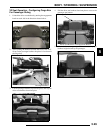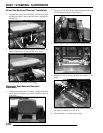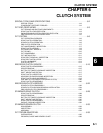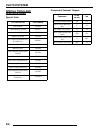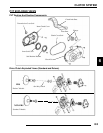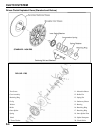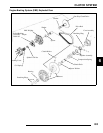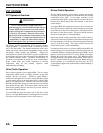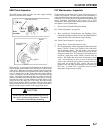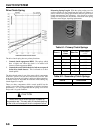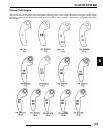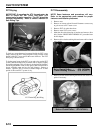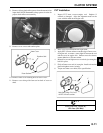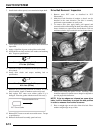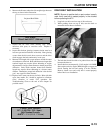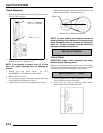
6.7
CLUTCH SYSTEM
6
EBS Clutch Operation
This EBS driven clutch provides the same engine braking
abilities as the EBS drive clutch.
When the ATV is moving the drivetrain turns in the direction of
engine rotation as the clutches, belt, and one-way clutches at the
same speed. When the drivetrain rotational speed exceeds the
one-way clutch rotation (see exploded view of drive clutch) , the
one-way clutch locks to the clutch shaft and engine braking
occurs. Essentially, the driven clutch has become the driving
clutch. The spider assembly with the two rollers, fixed to the
transmission shaft, rotates in the pockets of the sheave, allowing
the stationary sheave to rotate with the moveable sheave as the
rollers move to the other side of the ramp, providing instant
EBS. Engine braking (EBS) continues until the drive clutch
speed exceeds the one-way clutch speed, or until the throttle is
applied and the engine reaches clutch engagement speed.
PVT Maintenance / Inspection
Under normal operation the PVT system will provide years of
trouble free operation. Periodic inspection and maintenance is
required to keep the system operating at peak performance. The
following list of items should be inspected and maintained to
ensure maximum performance and service life of PVT
components. Refer to the troubleshooting checklist at the end of
this chapter for more information.
1. Drive to Driven Clutch Offset, Belt Width.
See “Clutch Alignment” on page 6.14.
2. Drive and Driven Clutch Rollers and Bushings, Drive
Clutch Shift Weights and Pins, Drive Clutch Spider Rollers
and Roller Pins, Drive and Driven Clutch Springs.
See “Drive Clutch Inspection” on page 6.17.
3. Sheave Faces. Clean and inspect for wear.
4. PVT System Sealing. Refer to appropriate illustrations and
photos. The PVT system is air cooled by fins on the drive
clutch stationary sheave. The fins create a low pressure
area in the crankcase casting, drawing air into the system
through an intake duct. The opening for this intake duct is
located at a high point on the vehicle (location varies by
model). The intake duct draws fresh air through a vented
cover. All connecting air ducts, as well as the inner and
outer covers, must be properly sealed to ensure clean air is
being used for cooling the PVT system. This also will
prevent water and other contaminants from entering the
PVT area. A sealed PVT is especially critical on units
subjected to frequent water forging.
CAUTION
Driven clutches must be disassembled from the
helix end to reduce spring pressure. Review all
information below before proceeding.
One-Way Clutch
Drive Clutch
Assembly
Downhill Belt
Rotation
Driven
Drive



